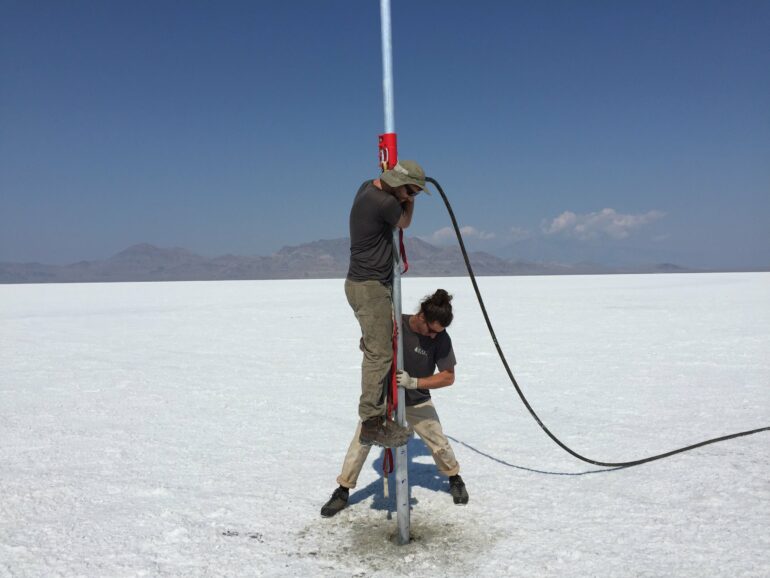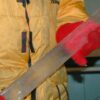It has been long assumed that Utah’s Bonneville Salt Flats was formed as its ancient namesake lake dried up 13,000 years ago. But new research from the University of Utah has gutted that narrative, determining these crusts did not form until several thousand years after Lake Bonneville disappeared, which could have important implications for managing this feature that has been shrinking for decades to the dismay of the racing community and others who revere the saline pan 100 miles west of Salt Lake City.
This salt playa, spreading across 40 square miles of the Great Basin Desert, perfectly level and white, has served as a stage for land-speed records and a backdrop for memorable scenes in numerous films, including “Buckaroo Banzai” and “Pirates of the Caribbean.”
Relying on radiocarbon analysis of pollen found in salt cores, the study , published in the journal Quaternary Research, concludes the salt began accumulating between 5,400 and 3,500 years ago, demonstrating how this geological feature is not a permanent fixture on the landscape.
“This now gives us a record of how the Bonneville Salt Flats landscape responds to environmental change. Originally, we thought this salt had formed here right after Lake Bonneville and it was a static landscape in the past 10,000 years,” said the study’s lead author, Jeremiah Bernau, a former U graduate student in geology.
“This data shows us that that’s not the case, that during a very dry period in the past 10,000 years, we actually saw a lot of erosion and then the accumulation of gypsum sand. And as the climate was becoming cooler and wetter, then the salt began to accumulate.”
And even more intriguing, according to the researchers, is the sediments immediately under the salt are far older, predating even the existence of Lake Bonneville. In other words, the old lake bed had largely blown away, indicating this landscape is far more dynamic than previously understood.
“We can show that a lot of material was removed before the salt came in,” said senior author Brenda Bowen, a geology professor and chair of the Department of Atmospheric Sciences who heads the U’s Global Change and Sustainability Center. “That’s really interesting when we think about what’s happening right now with the Great Salt Lake’s exposed lake beds and the potential for dust to be blown away and eroded.”
The nearby Great Salt Lake, a surviving remnant of Lake Bonneville, has greatly receded over the past two decades thanks to drought and decades of upstream water diversions. The research offers a potential forecast of what might happen if the Great Salt Lake continues to shrink.
Since 1960, scientists have been monitoring the Bonneville Salt Flats, as a part of lease agreements and management plans overseen by the federal Bureau of Land Management. The playa lost about a third of its salt volume over the past six decades.
Today, the crusts are 5 feet at their thickest point and cover an area of 5 by 12 miles at the foot of the Silver Island Mountains. Bowen began measuring the salt in 2016 with a research team that included Bernau, who joined the Utah Geological Survey after completing his doctorate.
But they went deeper than others had previously, drilling into the sediments below the salt, which is difficult to core through.
“The salt is quite brittle,” Bowen said. “You can’t use fluids or water generally [to aid in drilling] because it would dissolve the sediments.”
Instead, they used sonic drilling, which uses vibration.
“Once you get to the mud below the salt,” she said, “it’s like toothpaste and it just slides right through.”
Bowen and Bernau collaborated with the U geography department’s Records of Environmental Disturbance (or RED) Lab to drill additional cores in 2018 and 2020, this time using a device called a “vibracorer,” built by Isaac Hart, a former construction worker and welder who was then a graduate student in anthropology.
The equipment consists of a 21-foot-long irrigation tube affixed to a concrete mixer motor.
“The vibration of the motor allows the tube to be pushed down into the ground if the sediment is relatively fine-grained and soft (like the floor of the Lake Bonneville basin), after which we fill the tube with water and cap it off to create a vacuum so the dirt doesn’t drop out of the tube when we pull it out of the ground,” said Hart, a co-author in the study, said in an email. He is now a field director for the international nonprofit American Center for Mongolian Studies.
Bernau added, “This method was manually laborious, but we pulled out really gorgeous cores.”
They shared these cores, varying in length from 10 to 13 feet, with Charles “Jack” Oviatt, a co-author in the study, emeritus professor of geology at Kansas State University and a leading expert in Pleistocene lake beds, especially Lake Bonneville’s. After examining the sediments, Oviatt concluded they bore little resemblance to the Bonneville lake bed elsewhere.
“That really gave us the hint that we had something interesting on our hands,” recalled Bernau, who now works for private industry in Texas. To make sense of the cores, the researchers had to first pinpoint the ages of the salt crusts and their underlying sediments.
Scientists can determine. Applying this technique to the sediments, the researchers found dates going back more than 40,000 years, older even than Lake Bonneville itself, suggesting the prior presence of intermittent lakes.
Dating the overlying salt crusts was more tricky since radiocarbon dating requires organic material to analyze. In examining the salt cores under a microscope, however, researchers found what they needed to carbon date the salt: minute grains of pollen.
The team also examined sediment structures, mineralogy, diatoms and geochemistry to characterize the depositional record. Gypsum and carbonate strontium isotope ratio measurements were used to determine sources of water that carried the sediments to the salt flats.
“We threw all our tools into this study to get as much of a robust understanding of how this environment was changing through time,” said Bowen, whose study constructs a revisionist history for this place.
Lakes have been coming and going for tens of thousands, if not hundreds of thousands, of years in response to climatic changes, disappearing and reappearing as conditions alternate between wet and dry periods.
The data indicate the area now supporting the salt flats hosted a series of three shallow lakes between 45,000 to 28,000 years ago, that is, prior to the arrival of Lake Bonneville. After 13,000 years ago, the lake bed was exposed to wind erosion.
Three to six feet of sediment blew away before the water returned around 8,300 years ago, bringing the brines that eventually formed the salt flats we see today. The study shows that the Bonneville Salt Flats are more ephemeral than many appreciate, offering insights into how this special place could be managed differently.
“Sometimes we manage for the current landscape thinking that’s what it needs to be,” Bowen said, “but actually, it needs to be able to adapt and change.”
More information:
Jeremiah A. Bernau et al, Lateral and temporal constraints on the depositional history of the Bonneville Salt Flats, Utah, USA, Quaternary Research (2024). DOI: 10.1017/qua.2023.79
Provided by
University of Utah
Citation:
Utah’s Bonneville Salt Flats has long been in flux, new research finds (2024, February 21)



